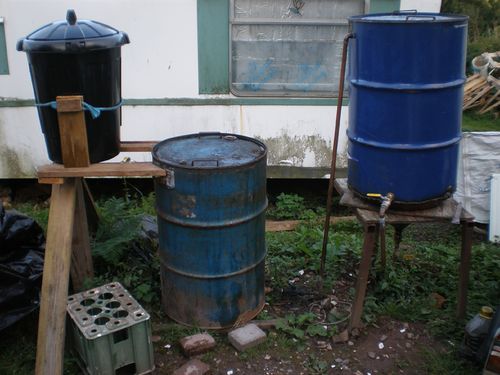Gravity filtering of WVO
Contents
Gravity filtering of WVO
WVO needs to be filtered, to remove any particles that may block the fuel filter in your vehicle. There are two main ways of doing this. One is using pressurised filters, covered elsewhere in this wiki, and the other is by using gravity. This is just one example of a gravity filtering system.
Some of the materials for the above system
The above system consists of a large plastic dustbin, two 45 gallon drums, less than 3 meters of 22mm copper pipe, a selection of copper fittings, three tank connectors, a manually operated ball valve, and a drill pump. Added to this are the filters, and a few other bits, which I will mention later.
.
Constructing the system
One drum has the top removed, and a cone welded to the bottom, this procedure is covered elsewhere on the Wiki. The second drum just has the top removed. They are not clip top drums, although clip tops would be ideal.
Flanges are welded to the outside of the left hand 45 gallon drum, to make the base for the dustbin. A hole is drilled in the drum, to allow the copper pipe through the drum, where it exits into a filter bag. The filter bag is hung on a flat piece of steel of the appropriate length, welded inside the drum.
A hole is drilled in the middle of the bottom of the dustbin, and a tank connector fitted. A piece of pipe is brought out from the tank connector on a 90 degree fitting, a valve fitted, and the pipe continued a suitable length to go inside the 45 gallon drum, an exit into the filter bag.
In the bottom of the drum, on the opposite side, a tank connector is fitted, as close to the bottom as possible. From here, the drill pump is plumbed in, and a pipe taken up and into the top of the conical drum, where it exits into another filter bag, fitted in the same fashion as the first. The conical drum needs to be situated high enough to get a five gallon drum under the outlet. In the system above, it is to low.
Handles are welded to the the drum tops, to aid with removing. If used outside, they need to be covered to stop water getting in.
The idea of the pipe exiting at the top of the cone was to drain off the good oil, and let the dropout sit in the cone. In practise, this did not work, and is not required.
Using the above system
In the dustbin is a bed sheet, held away from the sides and bottom of the bin by rolled up chicken wire. Without the chicken wire, the bed sheet seems to just stick to the bin, and not let oil through. Raw WVO is tipped into the bin, and the tap at the bottom of the bin is opened, allowing the oil to drain into the first filter. In this case the filter is 5 micron.
When sufficient oil has built up in the bottom of the 45 gallon drum, a drill is attached to the drill pump, and the oil is pumped into the filter at the top of the conical drum, where it goes into a 1 micron filter.
The filters will over flow if care is not taken when filling them
When sufficient oil has built up in the conical drum, Petrol is then added, at a rate of 10% and left to settle for around 24 hours. Slowly cracking open the valve on the bottom of the cone, will let any dropout and water out. The oil is then loosed into a 5 gallon drum, and is ready for use.
The volume of the cone itself is around 30 litres. Judging the quantity of oil in the conical drum comes with experience.
In use, the above system has proved capable of efficiently filtering WVO, in certain conditions. The advantages are that the oil is only handled once, before it is ready for use, and the bin is easy to tip the raw WVO into. Once the WVO is in the bin, the rest of the operation is simple.
In cooler conditions, it can be frustratingly slow.
An electric pump would be a major improvement, so the oil level could be watched when filling the last filter.
As in all filter bag systems, lining the filter bags with a pillow case, or similar, help enormously in keeping the filter bags clean. When the pillow cases fill with solids, it is simply a case of pulling them out and replacing them.
See also
http://www.biopowered.co.uk/wiki/Waste_oil_filtering_system
Greasemonkey 00:17, 10 November 2012 (GMT)
